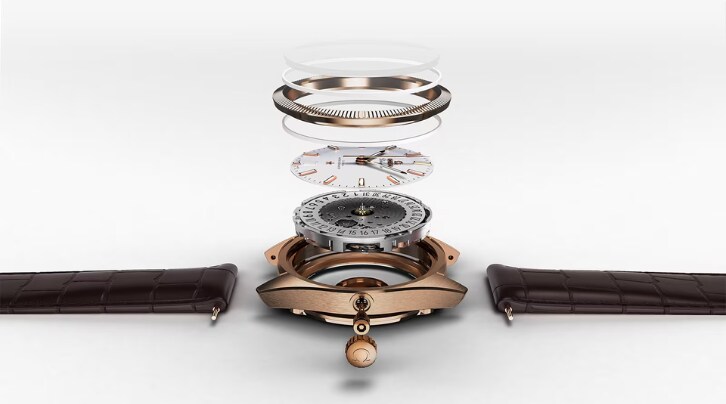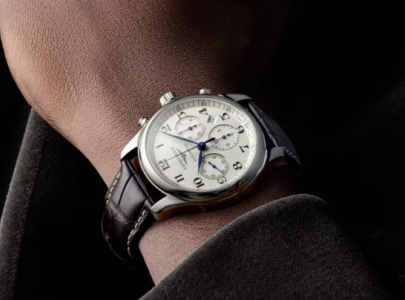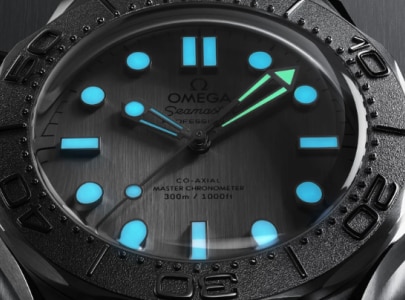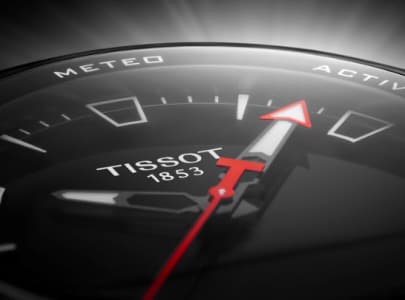In the silent yet vibrant world of horology, each watch is a symphony of parts—sometimes hundreds of components meticulously assembled together. From the evident beauty of their dials to the sometimes hidden mechanics within their cases, some watches are treasures of innovation and craftsmanship. Let's dive into the heart of these masterpieces from the visible to the invisible: dial, movement, hands, rotor, hairspring, and all the elements that make a timepiece a functional, mechanical object that tells time.
A ballet of hands and dials
Each watch begins its story unveiling its face commonly known as the dial. This is where the dialogue between the watch and its wearer begins; where the hours unfold in a precise choreography orchestrated by the hands.
Taking the Omega Seamaster as an example, its dial transports the wearer into another dimension of design, reminiscent of underwater ripples. Inspired by the vast expanses of the ocean, the "Teak Concept" wood pattern evokes the wooden decks of luxury yachts, while other models like the Seamaster Diver 300M are adorned with wave patterns that remind us of the undulating surface of the sea. These designs are not only aesthetically pleasing; they also reinforce the watch's identity as the quintessential diving instrument. In another design vein, guilloché work, as observed on Breguet or Blancpain dials, adds a significant visual and aesthetic signature. Halfway between art and technique, mastering guilloché requires ultra-precise craftsmanship. Guilloché is a decorative technique involving the engraving of repetitive, often complex and very fine patterns directly onto the metal parts of the watch, such as the dial, movement, or case. These patterns can take various forms: straight lines, curves, interlaced circles, rosettes... all aimed at adding a touch of elegance and refinement to the watch while highlighting the watchmaker's precision and skill. This technique requires a tool called a rose engine, a machine capable of executing these patterns with great precision, most often done by hand. In addition to its aesthetic aspect, guilloché improves the readability of the dial through the interplay of light reflection on the engraved patterns, which we regularly observe on the dials of models from the Marine or Reine de Naples collections. At Breguet, this technique has been elevated to a level of excellence, becoming a hallmark of the brand since its founder Abraham-Louis Breguet began using it in the 1780s.
To a similar extent, Breguet hands are a true signature. When observing the filigree hands, one cannot help but be captivated by their elegance and grace. They are much more than time indicators; they reflect a watchmaking heritage, a symbol of prestige that transcends generations. Breguet hands, often blued by a thermal treatment that gives them their rich and deep color, are recognizable by their "hollow apple" curvature, an aesthetic hallmark of the brand. This distinctive shape was not just a stylistic choice by Abraham-Louis Breguet; it was also functional, allowing for better visibility. Today, these hands have become emblematic, often imitated but never equaled, continuing to define the very essence of a Breguet watch.
Under the dial or where the heart of the watch beats
There is what we see at first glance, and then there is what exists but is not shown or seen unless the watch is "skeletonized," that is, the internal part of the watch, particularly its dial, is entirely openwork, lending itself to the play of transparency.
At the heart of every watch lies the centerpiece of engineering, a movement that beats with the regularity of a human pulse, as demonstrated by Omega's Co-Axial Master Chronometer movement introduced in 1999. We speak then of the apex in terms of horological engineering, where innovation rhymes with tradition. Designed to offer the ultimate in durability and precision, the Co-Axial movement is the result of many years of research and development aimed at pushing the limits of mechanical performance. The distinctive feature of Omega's Co-Axial movement lies in its innovative escapement system, developed in collaboration with master watchmaker George Daniels, which has revolutionized mechanical watchmaking. This escapement consists of three main elements: the escapement wheel, the anchor, and the co-axial impulse pinion. Unlike the traditional anchor escapement, which operates with friction, the Co-Axial escapement functions with a combination of friction and rolling. This innovation has reduced friction between components, leading to much better accuracy and reduced wear over time, enhancing precision. The movement requires less maintenance and fewer lubrications, resulting in longer service intervals and greater longevity. Moreover, the Co-Axial escapement contributes to the smooth and precise movement of the watch's second hand, which enhances its aesthetic appeal.
The movement is the heart where the balance wheel is its beat.
There are just a few horological visions can match the hypnotic beauty of the balance wheel in action, as in a Breguet Tradition. A balance wheel in a watch is a crucial component of the movement, serving as a regulator for the escapement system. It plays a fundamental role in time measurement by ensuring a steady advancement of time. The balance wheel oscillates at a stable frequency, generally determined by its construction and the balance spring (or hairspring) to which it is attached. This regular oscillation allows time to be divided into equal segments, essential for accurately measuring seconds, minutes, and hours. With its partially transparent dial, Breguet invites watch lovers to observe the rhythmic swing of the balance wheel, each oscillation captivating the gaze and reminding of the harmony of perfect mechanics. This open window into the watch's interior reveals not only the complexity of its design but also the elegance of its execution, highlighting the craftsmanship that has established Breguet as a legendary name in watchmaking.
The hairspring is an essential regulating organ for time measurement
Delicate and absolutely necessary, the hairspring is the vital breath of the balance wheel in the anatomy of a watch. At Blancpain, the innovative use of silicon to manufacture the hairspring of the Caliber 1315 reflects a marriage between horological tradition and cutting-edge technology. This advanced material gives the hairspring an insensitivity to magnetic variations, offering increased reliability and accuracy in conditions that would have once disrupted the delicate mechanism of a watch. Not content with simply enhancing performance, the silicon hairspring is also lighter and less prone to deformation than its metal counterparts, meaning that watches equipped with this type of hairspring, like some in the Blancpain Fifty Fathoms range, can maintain their accuracy over longer periods. It's thanks to innovations like this that Blancpain continues to stand out in the art of watchmaking, honoring its heritage while pushing the boundaries of modern technology.
The escapement: the timekeeper
Within each watch, the escapement plays the crucial role of timekeeper, a key component that ensures the regularity of each beat. In the various models from Omega, the Co-Axial escapement (of the famous revolutionary movement explained a bit earlier) stands out for its ability to reduce friction between components, thus ensuring durability and precision that last over time. This flagship innovation, a symbol of Omega's commitment, allows the watch to operate smoothly, transforming every second into a moment of unquestionable reliability.
The mainspring and the barrel: the unseen energy reservoirs
The mainspring, nestled at the heart of the barrel, is the energetic soul of the watch. As an example, in the Tissot's Powermatic 80 caliber, an optimized mainspring provides up to 80 hours of power reserve, offering remarkable autonomy for watch enthusiasts. This extended power reserve is a significant advantage, allowing one to set the watch aside for a weekend without the worry of it stopping. In Rado's arsenal, the barrel is designed to maintain this consistent energy, ensuring accuracy that accompanies the wearer at every moment. It's a promise of performance that translates into peace of mind for those who trust in the precision of their timekeeper.
Poetry in motion due to the oscillating weight
The rotor also referred as the oscillating weight or mass of an automatic watch is a marvel of ingenuity, an essential link connecting the wearer to the mechanical soul of their watch. It can be easily observed as a half-moon shape at the back of the watch when it is equipped with a sapphire case back, allowing one to see the rotor move with the simple movement of the wrist. Far from being a mere component, the rotor is the dynamic heart of the watch, a key piece that captures every daily gesture and transforms it into vital energy. The Hamilton Jazzmaster collection perfectly illustrates this mechanical magic. This oscillating mass moves freely in perfect symbiosis with the wearer's activities. Each rotation is a note in the symphony of time; each wrist movement is an impulse that keeps the watch alive.
This silent dance is made possible by a central axis that allows the rotor to pivot around the movement. The kinetic energy generated by this motion is transferred to the mainspring, which tightens progressively to store energy. It's a perfect fusion of form and function where the aesthetics of movement serve a practical purpose: to keep the watch running.
Eleonor Picciotto



